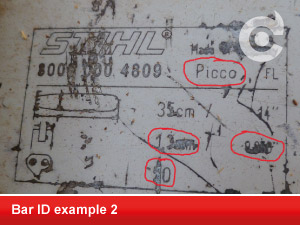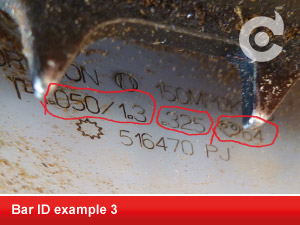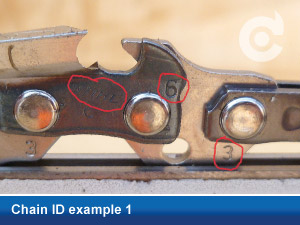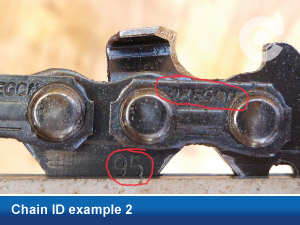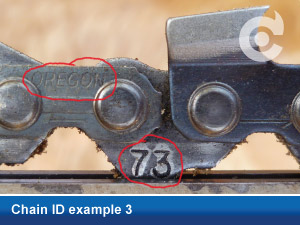Number of drive links
Again this will usually be written on the bar, but you can always count the number of drive links on an existing chain. Remember these are not the cutting teeth of the chain they are the parts of the chain that sit inside the bar. The number of drive links needs to be correct or you will either not be able to fit the chain (too few), or you will not be able to tension the chain (too many).
Identifying the chain from information on the bar
Bars are the best place to determine what size chain you are running. Have a look on the bar for numbers that would help indicate pitch, gauge and drive link count. Some bars are much clearer than others!
Bar ID Example 1
This tells us that the pitch is 3/8″, the gauge is .058″ and the number of drive links is 92.
Bar ID Example 2
The pitch here is a picco chain – Stihl’s way of saying 3/8 lo pro. Usually this is .050″ and this is confirmed here as 1.3mm or .050″. Finally the drive link count is difficult to make out – 50 drive links. In this case, double checking manually would be sensible.
Bar ID Example 3
Tucked in behind the saw dogs, this tells us the pitch is .325, the gauge is 1.3mm or .050″ and the number of drive links 64.
Identifying chain from the chain
Harder to identify but still rewarding. You can also count the number of drive links. Also look for numbers and letters on the chain itself. Click here for our chain ID chart to help you find out what these numbers mean.
Chain ID example 1
The chain tells us it is made by Stihl. The number 6 on the cutter tells us the pitch is 3/8 lo pro or (picco) and the number 3 on the drive link indicates a gauge of .050″ (or 1.3mm).
Chain ID example 2
The chain tells us it is an Oregon chain. The number on the drive link says ’95’ and on the chart below we can see the pitch is .325 and the gauge is .050″ or 1.3mm.
Chain ID example 3
Again we have an Oregon chain. The number on the drive link says 73 and the chart tells us it is a 3/8 pitch chain and .058″ gauge (or 1.5mm).
Click here for our chain ID chart

 text or whatsapp us
text or whatsapp us  orders@chainsawbars.co.uk
orders@chainsawbars.co.uk
 sign me up
sign me up basket
basket 
